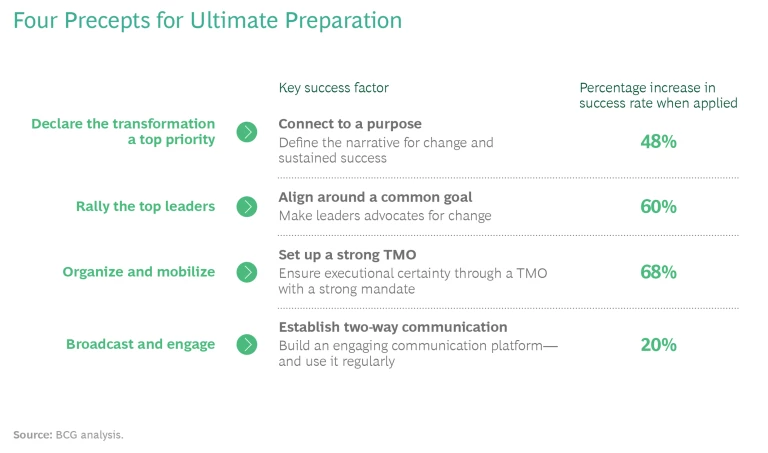What are the most important issues to focus on when you embark on a business transformation? Ask ten executives, and you’ll get ten different answers. In the critical first 100 days, there are many considerations to weigh, decisions to make, and actions to take—and their timing and sequence can be as instrumental to success as the moves themselves.
Clearly, it’s impossible to focus on everything at once. Any effort to do so will inevitably fall short and may put the entire undertaking at risk. Leaders must prioritize. And while prompt, decisive action is vital, no organization succeeds by attempting to go as fast as possible the whole way. A transformation is more of a marathon than a sprint: it requires time and pacing. Mindset and motivation matter as much as strength and stamina. At the starting line, you must be fully prepared for what lies ahead, both physically and mentally—including the rough patches you will invariably encounter.
So how do you ensure the company is on track to reach its goal? What can you do to be fully prepared and able to persevere? In this article, we present four precepts that companies can follow in those first 100 days to lay the strongest possible foundation for their transformation’s success.
Four Precepts for Ultimate Preparation
Drawing from BCG’s annual global survey of 1,000 companies, we examined 3,000 transformations, correlating specific actions with the transformation’s outcome. These changes ran the gamut from business model shifts and digitalization to restructurings. We asked respondents about their level of preparation at specific junctures of success or failure. To filter out subjectivity as much possible, we set out to identify the factors that correlate with actual success.
We derived four precepts for launching your transformation on the best path to success: declare the transformation a priority; rally the top leaders; organize and mobilize; and broadcast and engage. (See the exhibit.) By adopting these measures, companies will be positioned to swiftly create momentum. Once underway, their transformation can advance with minimal bumps along the route. And when roadblocks or setbacks do arise, companies and their people will be better equipped to overcome them.
Declare the Transformation a Top Priority
According to BCG research, transformations that are visibly treated as a high priority have a success rate of up to 48% greater those that are not. Leaders who broadcast at least one clear, compelling reason beyond growing revenues—such as improving quality, innovation, or customer service, or even a providing a societal benefit—achieve better results.
Leaders need to frame the impact of the transformation as something central to the company’s purpose—the value that sustained success will deliver to all its stakeholders.
Equally important, leaders need to frame the impact of the transformation not just in dollar terms but also as something central to the company’s purpose—the value that sustained success will deliver to all its stakeholders. People will get behind a transformation when they see its connection to the customer, brand value, or societal goals. Moreover, because the changing context will challenge employees with added pressures and a greater workload—and often uncertainty about the path forward—people are more likely to commit to change when they feel enlisted in the endeavor, rather than when it is imposed on them.
Rally the Top Leaders
The importance of participating in the change applies across the board—from leaders at all levels to every employee. Our research shows that transformations in which leaders focused on reaching alignment early on were as much as 60% more successful. If leaders are united and embrace change, they can focus on achieving the outcome, rather than on announcing intentions.
Top leaders must actively participate in the transformation. They must hold candid, no-regrets discussions up front to surface any resistance, find out why any colleagues are skeptical, and address legitimate concerns to the extent possible. Remember—no company can afford resistance or dissent from those in positions of authority.
To get people on board, define the transformation’s goals and show how they will advance company’s strategy. Then forge your implementation plan, including the ways in which people will work to carry out initiatives. Identify potential stumbling blocks and how they might be overcome. Alignment isn’t merely driven by logic or aspiration, so you need to establish—or more likely, readjust—management incentives to match transformation targets.
According to Hans Gennen, a coauthor of this article and COO at Currenta, the European industrial site operator, his company’s leadership team recognized the value of developing the company purpose and transformation narrative in tandem. Over the course of eight weeks, Gennen convened the company’s top 50 leaders and selected employee groups for intensive workshops and discussions. Although more time-consuming and complicated than the traditional top-down communications, this approach instilled in participants a sense of responsibility for the transformation. They became advocates for change. Ultimately, this approach proved essential in advancing the effort successfully.
Organize and Mobilize
The companies in our study that reported being properly prepared for their transformations enjoyed a 68% higher success rate. In other words, if you don’t get it right from the start, chances are you won’t get it right at all.
Be properly prepared for your transformation. If you don’t get it right from the start, chances are you won’t get it right at all.
A transformation requires a process and a team to ensure that the multitude of initiatives can be monitored and managed. It also requires an entity to promote alignment across the organization. Because the multiple components and dependencies need to be orchestrated, adequate preparation and the coordination of individual projects and initiatives is essential.
Setting up a transformation management office (TMO) at the outset is crucial to ensuring that every move goes as planned. The TMO is a central clearinghouse that executes on all transformation initiatives and processes. To be effective, it needs clearly defined roles; a dedicated, senior-level leader (the chief transformation officer, or CTO); and its own staff. The TMO also enlists others in the organization (or even externally) to contribute to the effort.
Equipped with a strong mandate from the C-suite, the TMO is the umbrella organization that coordinates and drives the transformation activities, ensuring that people row in the same direction. It provides the processes and tools, tracks progress and value capture, and ensures alignment. It supports workstreams and initiative owners’ goals. The TMO also inventories the resources needed for the transformation—people, expertise, tools, and funds—and lobbies to fill gaps, which may require senior leadership to intervene to halt or forestall competing priorities. And it identifies weak points and risks and develops contingency plans to avert or surmount roadblocks that impede progress or that could upend the transformation entirely.
Broadcast and Engage
Two-way communication is essential for maintaining both leaders’ and employees’ support. Successful transformations require clear communications to spur motivation and action. Those at the top must also continuously seek feedback from the organization. Companies that make a point of not only disseminating news but also of actively soliciting feedback have enjoyed a 20% higher rate of value creation.
Map a clear communication strategy. Develop a communication roadmap (a six-month rolling plan works well) that includes short-term tactics that keep people informed and the messaging fresh. Communications should cover the high-level “whys” and “whats”—the strategy and the game plan—as well as more on-the-ground progress reports.
Candor about uncertainties and challenges reinforces your credibility and gains employees’ trust and support.
Be forthright about performance shortfalls as well as accomplishments. Candor about uncertainties and challenges, and how you are preparing for them, reinforces your credibility and gains employees’ trust and support. Motivational talks shouldn’t be reserved for reaching major milestones; they can help people get through low points.
Plan frequent pulse checks and feedback loops. Apart from tracking progress and monitoring for potential stumbling blocks, soliciting reports from the front lines also reinforces the notion that transformation is a team effort—and thus helps to sustain motivation. In addition, it’s useful to reach out to employee groups across the organization to get their views and support. Before the launch, think of opportune points along the journey where you could include these groups.
Consider the approach IKEA Retail (Ingka Holding) has taken with its transformation. Before launching, the company evaluated its operating model, identifying a number of challenges it would have to overcome to make the transformation a success. From the beginning, it has surveyed its people regularly about those challenges to monitor progress, attitudes, and the perceived degree of change. These surveys help leaders know where to direct their attention and help them identify the tools needed to course-correct. They also demonstrate to employees that their feedback matters.
Just as they do with new CEOs, companies can designate the first 100 days of a transformation as a time to gather resources, think it through, and prepare leaders and the organization for the marathon ahead. The journey will present both opportunities and obstacles, so make sure you have the capabilities and the capacity to adjust—and the right mindset to navigate uncertainty. The best marathoners may appear to run alone, but every one of them is supported by a team of specialists. To boost your odds of success, organize and mobilize your teams so you can approach the starting line fully prepared to reach the finish line. The additional time you spend up front—in designing the program, rallying the troops, and setting forth policies and principles—will be paid back in multiples once the transformation is underway.







